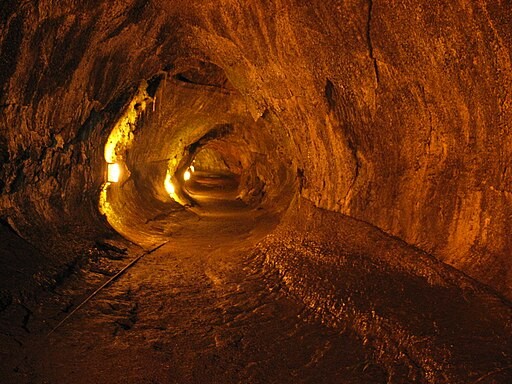Every year, tourists and researchers worldwide visit the Umm Jirsan lava tube complex in the Arabian Peninsula to explore the network of underground tunnels formed by lava flows millions of years ago. The geological wonder can be found in Harrat Khaybar, one of the largest volcanic fields in Saudi Arabia, which last saw an eruption during the 7th century C.E.

(Photo: Wikimedia Commons/ Michael Oswald)
Ancient Human Shelter
In a recent study, archaeologists discovered that humans lived in the lava tube at least 7,000 years ago or earlier. The Umm Jirsan lava tube is approximately 78 miles (125 kilometers) north of Medina.
In the paper "First evidence for human occupation of a lava tube in Arabia: The archaeology of Umm Jirsan Cave and its surroundings, northern Saudi Arabia," the research team claims that in terms of the horizontal length of passages, Umm Jirsan is currently the most extended reported lava tube in Arabia at 4,859 feet (1,481 meters). It is also believed that prehistoric humans and their livestock periodically lived inside these naturally hollowed-out structures during the Neolithic Age and Bronze Age.
While ancient humans are known to have lived on the Arabian Peninsula during prehistoric times, organic remains are limited due to poor preservation in the arid region. Because of this, the researchers searched for areas that would have preserved artifacts because they were protected from the Sun, wind, and wild temperature changes over the past millennia. Umm Jirsan lava tube complex met these criteria, so the researchers decided to explore it.
Their exploration turned out to be good. The archaeologists discovered artifacts like the rock art of domesticated animals, fragments of cloth and worked wood, and the skeletal remains of nine human bones. The discovery suggests that ancient humans possibly occupied the lava tube network as far back as 10,000 years.
This theory was based on radiocarbon dating and optically stimulated luminescence dating, which examines the last time certain minerals were exposed to what or sunlight. According to study co-author Mathew Stewart, some dates are relatively recent, and the tube appears to have been used in modern times.
Stewart noted that it is difficult to say when Umm Jirsan was last filled with lava, although volcanic activity has occurred intermittently in the region. Over the past 1500 years, there have been some 1500 volcanic eruptions in the Arabian Peninsula and many more during ancient times.
READ ALSO: Ancient Hawai'ian Lava Caves Home to Various Microbes Harboring Toxic Materials, Gases
What is a Lava Tube?
Caves are usually associated with stalactites and stalagmites, but there are several other caves. The second most common type of cave are lava tubes, which are formed due to volcanic eruptions.
A lava tube is a natural conduit created by lava flowing from a volcanic vent and moving beneath the hardened surface of a lava flow. Also known as pyroducts, they are found worldwide in places where fluid lava has flown over the surface.
Lava is thousands of degrees hot and can flow like a river. The top part of this white-hot river cools as it gets exposed to the much colder temperatures in the air. As it cools, the lava solidifies into black stone, flowing below the molten river. Meanwhile, the rock above the river keeps cooling, thickening, and widening until it finally forms a roof across the molten rock below. This roof eventually creates the ceiling of the cave. As the eruption ends or when the lava flow moves to somewhere else, the lava tube drains of molten rock, leaving a cave tunnel behind.
RELATED ARTICLE: What Are Lava Tubes? How Did Ancient Volcanoes Form These Natural Conduits?
Check out more news and information on Lava Tube in Science Times.











!['Cosmic Glitch' in Einstein's Theory of General Relativity Could Be Explained in This New Scientific Tweak [Study]](https://1721181113.rsc.cdn77.org/data/thumbs/full/53435/258/146/50/40/cosmic-glitch-in-einsteins-theory-of-general-relativity-could-be-explained-in-this-new-scientific-tweak-study.jpeg)


